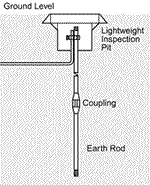
The resistance of a single earth can be calculated if the soil resistivity is known. An earth rod driven vertically, the electrode resistance can be calculated using the following formula.

where:
R = electrode resistance, Ω
ρ = Soil resistivity, Ω-m
L = Length of electrode buried in soil, m
d = Outer diameter of earth rod, m
Note: In Australia the minimum depth of vertical type earth electrode is 1.2 m [Clause 5.3.6.3, AS/NZS 3000 - 2007]
The soil resistivity at the location of the earth rod needs to be investigated. The resistivity of soils varies with
- the depth from the surface,
- the type and concentration of soluble chemicals in the soil,
- the moisture content, and
- the soil temperature.
In other words, the soil resistivity is dependent on the electrolyte in the soil. The presence of surface water does not necessarily indicate low resistivity.
In the absence of soil investigative data, typical resistivity of various soil types is given in the following table.
Typical soil resistivity (IEEE 142)
| Soil Type | Average Resistivity Ω-m |
|---|---|
| Well-graded gravel | 600 - 1000 |
| Poorly graded gravel | 1000 - 2500 |
| Clayey gravel | 200 - 400 |
| Silty sand | 100 - 800 |
| Clayey sands | 50 - 200 |
| Silty or clayey sand with slight plasticity | 30 - 80 |
| Fine sandy soil | 80 - 300 |
| Gravelly clays | 20 - 60 |
| Inorganic clays of high plasticity | 10 - 55 |
Example:
Soil resistivity = 180 Ω-m
Earth rod = ø19mm x 1.8 m
Solution:
Assuming that the earth electrode is fully driven into the ground, the resistance will be


In the event that the desired soil resistivity is not achievable using a single earth electrode, multiple electrodes could be used. The multiplying factors for multiple electrodes are given in the following table
Multiplying Factor of Multiple Electrodes(IEEE 142)
| Number of electrodes | Factor |
|---|---|
| 2 | 1.16 |
| 3 | 1.29 |
| 4 | 1.36 |
| 8 | 1.68 |
| 12 | 1.80 |
| 16 | 1.92 |
| 20 | 2.00 |
| 24 | 2.16 |
References
- IEEE 142 (Green Book) 2007IEEE Recommended Practice for Grounding of Industrial and Commercial Power Systems
- Practical Grounding, Bonding, Shielding and Surge ProtectionG. Vijayaraghavan, Mark Brown, Malcolm BarnesNewnes 2004 - IDC Technologies
- AS/NZS 3000 - 2007 Wiring Rules

Ver, I am Eric from Muscat, Oman. Pinagsusubmit kasi kami ng consultant para sa computation ng group resistance sa lahat ng electrodes sa buong runways and taxiways. confuse ako kasi mahigit 500 units ang gagamitin namin which is wala na sa list ng 7430 ang factor.
ito ung mga give:
Soil Resistance: 9.5 ohm-meter, silty sand
Length of Rod: 3 meters, driven full length
Diameter: 16mm
Material: Solid Copper
Spacing: 120m
kailangan ko po ng Group resistance, salamat po.
Hi Eric,
Di ko alam kung ano ang standard ng Oman, pero kung base sa Australian standard (AS 1768), which is derived from IEC TC 81, ang group resistance ng mga earth rods kung ang spacing between earth rods ay mahigit sa 2x Earth rod lengths is equal to the parallel resistances of all the single earth rod resistances. To quote:
Kung ang spacing mo ay 120m, ito may malayong higit sa 2x3m, kaya ang formula na ito ay valid.
thanks a lot for your information
but i want to know how can i no the exact number of earthing electrodes?
Depending on your country, there is an allowable maximum earthing resistance. In Australia, for lightning protection, 10-ohms. The result of your calculation should not be greater than the acceptable value.
You may want to see also this article.
Thanks for asking.
s.pangonilo.com – da best. Keep it going!